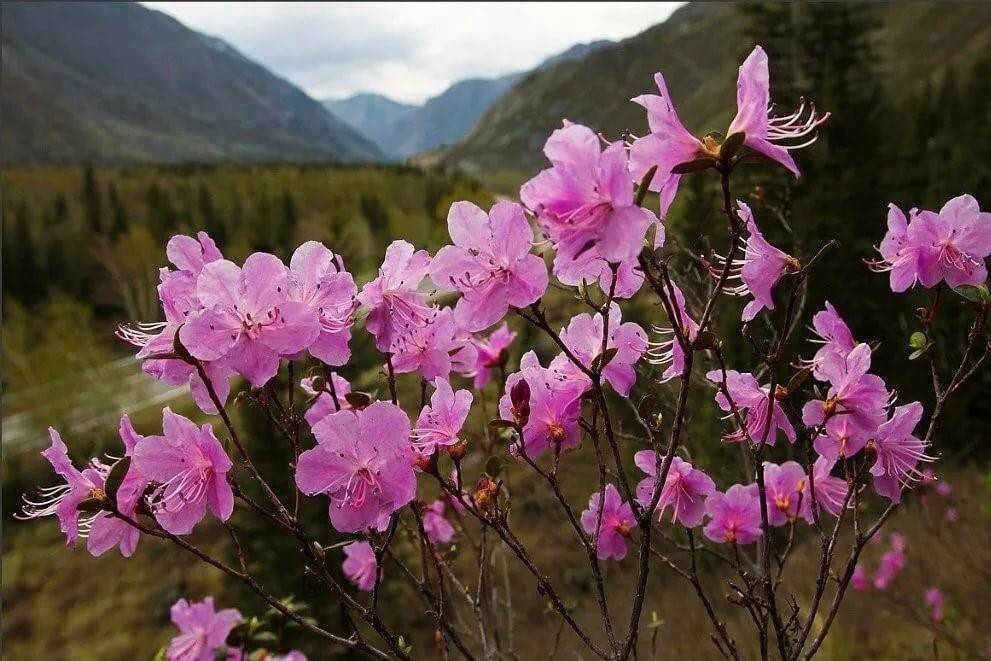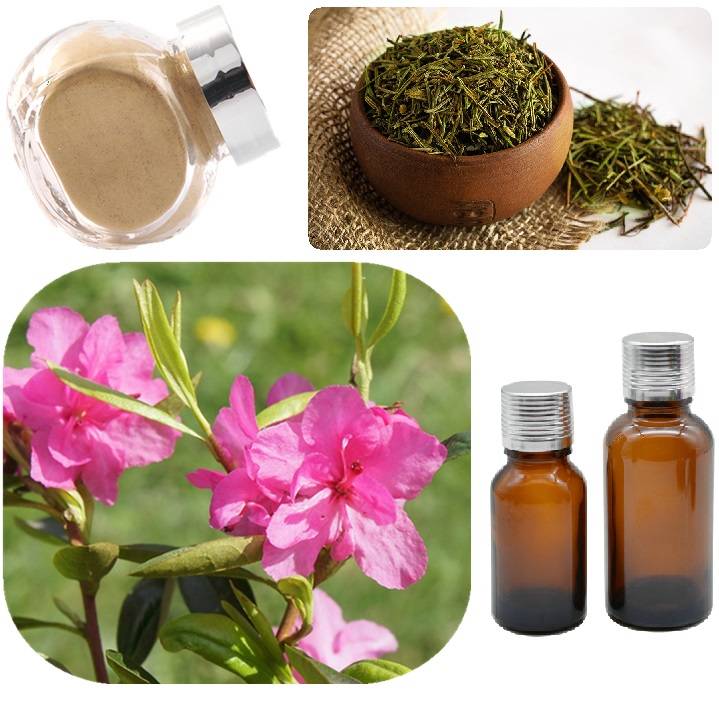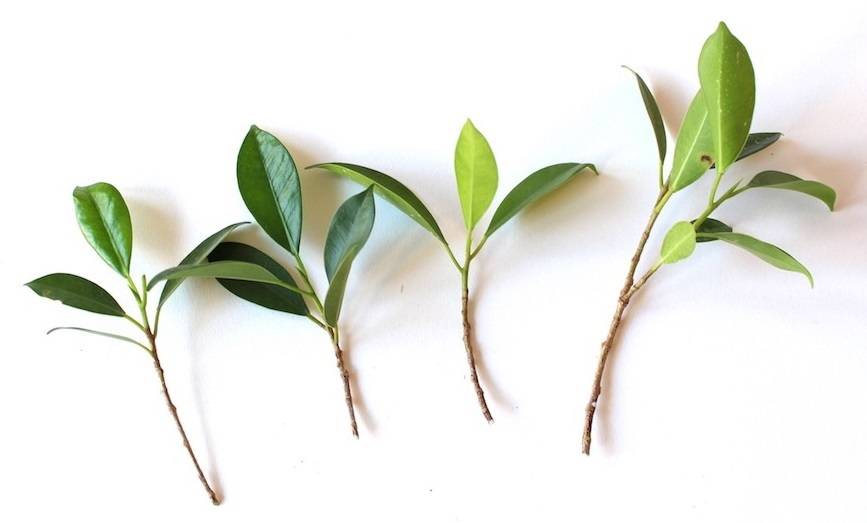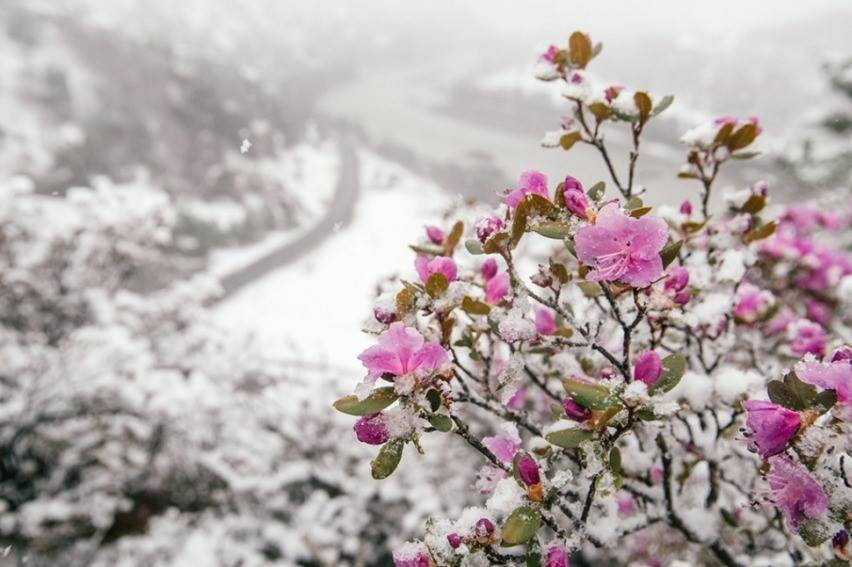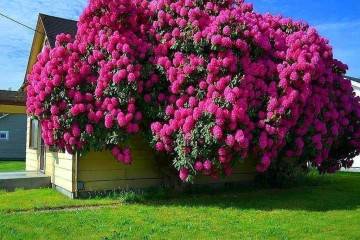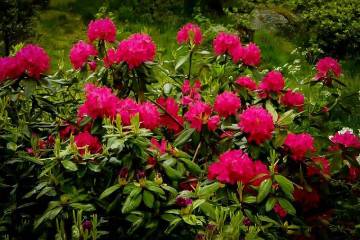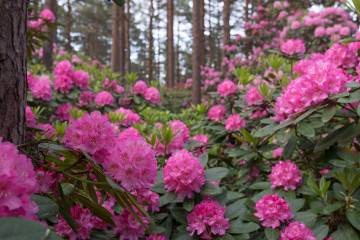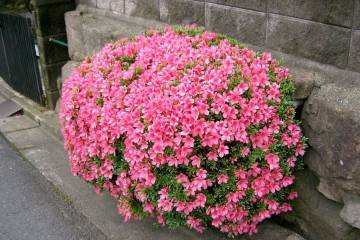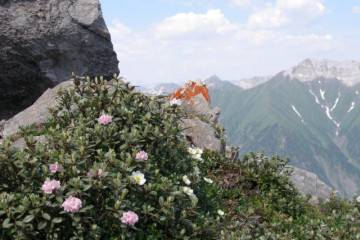Far Eastern rhododendron daurian
Content:
Daurian rhododendron (aka Far Eastern rhododendron) attracts many gardeners with its lush flowering. Having planted this unpretentious plant, in a few years it will be possible to admire its magnificent inflorescences.
Biological description
Rhododendron and wild rosemary are one and the same plant, there is no difference between them. It is a shrub 2 m high, prone to strong branching. Leaves are oval, small, glossy, on short petioles. Pink-purple buds are formed at the tips of the shoots, and when fully opened, they are up to 4 cm in diameter. The flowering period depends on climatic and weather conditions, approximately in April-June. The fruit is a kind of rounded box. The plant can withstand frosts down to -45 ° C, but does not tolerate frequent thaws in winter.
The chemical composition of rhododendron
The leaves and flowers of rhododendrons contain many active substances: flavonoids, tannins, sugars, organic acids, essential oil, ascorbic acid, andromedotoxin (aka rhodotoxin). The last component is capable of carrying both benefits and harm: it can be dangerous when consumed in excess of dosages. Due to its medicinal properties, the plant is in demand in pharmacology.
Beneficial features
Medicines based on Daurian rhododendron have a bactericidal, diuretic, antipyretic, sedative and analgesic effect. However, due to the poisons contained in the rhododendron, preparations made from it are contraindicated during pregnancy and during lactation. In addition, they should not be taken when there is tissue necrosis or chronic kidney disease.
What diseases does rhododendron treat?
With the help of raw materials obtained from the plant, you can fight many diseases:
- adding infusion of leaves to the bath helps with neuroses, radiculitis;
- the infusion is used for insomnia, neuroses and in the treatment of colds;
- taking a decoction is recommended for diseases of internal organs, including the cardiovascular system and as a diuretic;
- the tea is used to relieve migraines and treat sore throats.
Seed propagation
Seeds are most often propagated by wild varieties of Daurian rhododendron, which have a high percentage of germination. Surface sowing of seeds without burying into the soil is carried out in February-March. Watering should be done with thawed or ordinary acidified water. The container is covered with foil and left in a room with a temperature of 20 ° C.
Propagation by cuttings
Varietal rhododendron is best propagated by cuttings. To do this, in the second half of summer, strong shoots up to 10 cm long are cut off and planted in a substrate with high acidity at an angle of 30 °. The cuttings are watered, covered with a film, creating a greenhouse effect, and left to germinate in a room with a temperature of 23 ° C. After 2 months, the cuttings are planted in separate containers.In spring, seedlings can be transferred to open ground or grown in the same container for 1-2 years.
Root layers
When there is already an adult plant on the site, then it can be propagated by layering. In spring or autumn, leaves are removed from the middle part of a strong long shoot, located low above the ground, and the upper ones are cut to half. The shoot is bent to a previously prepared shallow trench, laid in it and sprinkled with earth, leaving the upper part with shortened leaves on the surface. The soil above the shoot is moistened and mulched. You can transplant a young plant in the second year.
Dividing the bush
This breeding method is the easiest. The plant is carefully dug up and divided into parts, each of which has healthy roots and shoots. This is followed by a transplant according to all the rules necessary for rhododendrons.
Shrub planting
The landing site must be bright, but shaded from the sun, sheltered from the winds. The soil on the site must be nutritious, have high acidity and air permeability. Stagnation of moisture at the landing site is unacceptable.
Preparing the planting pit, it is filled with a soil mixture based on earth and peat with the addition of pine needles and sand. A drainage layer (at least 15 cm) of expanded clay or broken red brick is required.
Care
It is not at all difficult to grow a dahurian rhododendron bush, planting and caring for which is quite simple. It is enough to comply with the rules of agricultural technology: fertilizing, irrigation with rain or acidified water, removing weeds. Pest and disease control is carried out as needed, but in order to avoid this, it is recommended that the plant be prophylactically treated with appropriate preparations.
Loosening and weeding procedures
Due to the shallow root system, it is not recommended to loosen the shrub so as not to harm the plant. In extreme cases, the procedure can be carried out, but as carefully as possible.
Diseases and pests of wild rosemary
Despite the strong immunity, the plant can be subject to the following diseases:
- chlorosis (it is required to spray the shrub with a solution of ferrous sulfate);
- necrosis (watering needs to be adjusted);
- root rot (the plant needs to be transplanted to a suitable location).
The most common pests - mealy worms, weevils and slugs - are fought with insecticides.
Watering and feeding
The shrub is watered after the earth dries. Watering during the flowering period, you need to be careful so that water does not get on the flowers, this can lead to a loss of decorative qualities and decay processes.
Top dressing consists in the annual, starting from the third year of the plant's life, the introduction of compost and humus at a shallow depth after the end of the flowering stage.
Pruning
Daurian rhododendron does not require crown formation. Old bushes rejuvenate by shortening the shoots to a length of 30-40 cm. To do this, use a sharp sterile tool, treating the sections with brilliant green or garden pitch.
Shelter for the winter - is it necessary or not
Since this type of rhododendron is able to withstand a drop in temperature to -40 ° C, only young trees (no older than 2-3 years old) are covered, spudding them with peat and wrapping them with agrofibre. An adult plant is not covered for the winter.
Daurian rhododendron (wild rosemary) is very beautiful and hardy. Its lush crown, especially at the time of flowering, will decorate any personal plot. The shrub looks great both in group and in individual plantings, and it is not so difficult to care for it.
